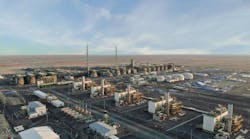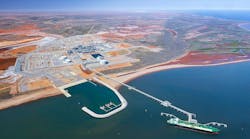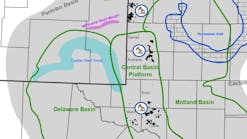Chevron forecasts 2025 Permian production to climb 9-10%
Chevron Corp., Houston, is forecasting 2025 total oil and gas production will climb 6-8% from last year’s nearly 3.34 MMboe/d, executives said Jan. 31. That growth is expected to pick up in second-half 2025 thanks to projects in the Gulf of Mexico and Kazakhstan but Permian basin assets also are expected to grow production about 10% despite receiving less investment.
Speaking after Chevron reported its fourth-quarter results—net income of $3.24 billion on revenues of $52.2 billion—chairman and chief executive officer Mike Wirth and chief financial officer Eimear Bonner said they are focused on capital efficiency and expect Chevron to grow its free cash flows by $2 billion by end-2026.
Lower capital spending will be part of that: Chevron’s capex totaled $15.8 billion in 2023 and $16.4 billion last year, investments that helped the company set oil and gas production records that were driven in part by Permian basin output climbing 18% in 2024.
This year, total capex is projected to be about $15 billion—with operations in the Gulf of Mexico (Chevron has begun using the ‘Gulf of America’ name instituted by the Trump administration) and Central Asia getting more money and Permian assets receiving less (OGJ Online, Dec. 6, 2024). Executives’ initial range for 2026 capex is $14-16 billion.
“Could we be at the low end of the range? We could,” Wirth said on a conference call. “We’ll make that call based on the opportunity set, the competitiveness of those [and] our view on the market outlook. The real message here is: I think you can depend on us to remain very disciplined and we’re getting more for every dollar we’re spending. […] The Permian is growing with 40% fewer rigs than our plans contained just a few years ago.”
Chevron’s output in the Permian should grow 9-10% this year, Wirth said, and “a little bit less than that” in 2026. The company’s holdings there will produce more than 1 million boe/d per day “for many, many years into the future,” he added.
Combined with similar low-decline assets in the Denver-Julesburg and Bakken basins, among others, that production will allow Chevron to keep investing in development and exploration opportunities such as those in the Eastern Mediterranean, Argentina, Venezuela, and West Africa.
Chevron also is targeting $2-3 billion in cost cuts that will come from the combination of asset sales—Chevron disposed of nearly $8 billion worth of business last year—as well as efficiency improvements from well designs, for instance, and technology gains.
Looking at this year's first quarter, Wirth and Bonner said turnarounds and downtime work in Chevron’s upstream group may reduce output by about 45,000 boe/d.
Shares of Chevron (Ticker: CVX) were changing hands around $149.20 in early-afternoon trading Feb. 3 after closing above $156 before the company’s earnings report. Shares are essentially flat over the past 6 months, leaving the company’s market capitalization around $262 billion.

Geert De Lombaerde | Senior Editor
A native of Belgium, Geert De Lombaerde has more than two decades of business journalism experience and writes about markets and economic trends for Endeavor Business Media publications Healthcare Innovation, IndustryWeek, FleetOwner, Oil & Gas Journal and T&D World. With a degree in journalism from the University of Missouri, he began his reporting career at the Business Courier in Cincinnati and later was managing editor and editor of the Nashville Business Journal. Most recently, he oversaw the online and print products of the Nashville Post and reported primarily on Middle Tennessee’s finance sector as well as many of its publicly traded companies.




